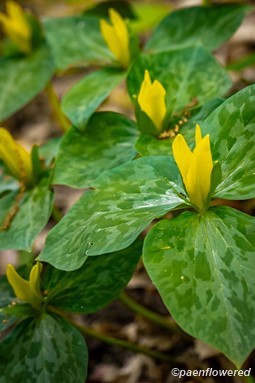Trillium luteum
Trillium luteum yellow trillium
Yellow trillium is a rhizomatous perennial herb in the Melanthiaceae (bunchflower) family. Like all true trilliums, it lacks conventional stems and leaves; instead, what appears to be a stem is a scape emerging from underground rhizomes, and the three showy "leaves" are actually bracts - leaf-like structures that perform photosynthesis but do not arise from leaf nodes.
Flowering from April to May, this plant’s bright yellow flower emerges directly from the center of its mottled bracts, a characteristic feature of sessile trilliums, releasing a lemony fragrance that makes it a favorite in woodland gardens and native landscapes. It thrives in deciduous forests, especially those with calcareous substrates, and is primarily native to the southern Appalachian Mountains, where it often forms large colonies in rich, shaded slopes.
Habitat & Range
Rare in moist decidious forests. Prefers part shade to full shade and moist, well-drained, humus-rich soil.
Mostly found in the south-central part of the state.
Range: Native to the southern Appalachian region, extends from southeastern Kentucky to northern Georgia. Widely introduced beyond its native range, with established populations in Pennsylvania, Maryland, Michigan, and parts of Canada, including Quebec and Ontario.
Wetland Code: Not classified
Phenology
Flowers April & May.
Characteristics
Inflorescence sessile, solitary flower
Flowers 3 yellow petals, erect, sessile; stamens erect with greenish white filaments and yellow anthers; ovary pale green; stigmas erect, barely spreading
Leaves(bracts) three in a whorl beneath the flower, sessile, mottled with green or gray-green, broadly ovate-elliptic; up to 6⅔″ long
Stem(Scape) stout, glabrous, extending from rhizomes; maroon or purple at base, producing cataphylls
Fruit greenish, ovoid, 1.4″ long
Height 12-18 inches
Plant Codes
S-rank: No Rank
G-rank: G4 (Apparently Secure)
Ecology
Seeds are dispersed by ants, which transport them to underground nests and aid in germination. The foliage is occasionally browsed by white-tailed deer, whose foraging can impact plant vigor and flowering.
Bumblebees and yellow jackets are the primary pollinators attracted to the flowers lemony scent and bright yellow petals. Solitary bees, butterflies and moths visit the flowers for nectar.
APG/Taxonomization Info
Historically, this species was considered a yellow-flowered variation of Trillium cuneatum, but since 1901 has been recognized as a distinct species, differentiated by flower color, fragrance, and geographic distribution.









Comments
Have you spotted this plant in your area? We'd love to hear about your experience! Share your comments or questions about the plant below. Comments are moderated before posting.